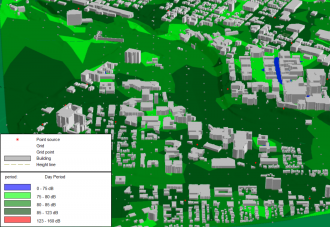
The engineering team at Akoustik recently completed a large-scale acoustical study of the downtown area of the City of Minneapolis for the hardware selection and placement of an outdoor warning siren system. This acoustic study had two primary goals. The first was to determine the minimum required sound pressure level (SPL) that the siren would need to produce throughout the study area based of the present predicted worst case ambient sound pressure levels. In order to do this, a model of the typical ambient levels based on worst-case traffic SPLs was determined. The second goal for the study was to recommend a siren model(s) and optimize the quantity and locations for the sirens that meet the coverage target level(s) as per the guidelines given by “The United States Federal Emergency Management Agency (FEMA) 2006 Technical Bulletin, Outdoor Warning Systems”, as well as the requirements specified by the City of Minneapolis. The requirements from the City were very strict and included a minimum of 90% acoustical coverage as well as narrow window of an acceptable minimum sound pressure level and weight limit for the selected siren system. In addition to a minimum SPL, the selected siren system was also limited to a maximum SPL at a listener’s location.
As mentioned, the target sound level that was required to be met was achieved by obtaining roadway traffic information and subsequently modelling the propagation at the nearest pedestrian location. Several roadway types were modelled based on the traffic volume with Brüel & Kjær Predictor software using the TNM algorithm. As a result the downtown area of the City was separated into several zones based on the ambient noise level. In order to accurately model the sound propagation of a siren system throughout the City, the buildings and topography information were required. This information was acquired by a third party using LIDAR technology; a portmanteau of “light” and “radar”, the remote sensing technology measures a distance by illuminating a target with a laser and analyzing the reflected light. Utilizing the LIDAR data, the sound energy of the siren system could be modelled accurately. The final component of the pre-model portion of the study was to acquire the manufacturer specifications for all siren systems that met the both the City’s and the FEMA requirements.
Utilizing Brüel & Kjær Predictor software, all of the information was inputted into the model and the process of trial and error in determining the minimum number of siren units to meet the required coverage was underway. Several scenarios were modelled including different siren manufacturer combinations, to maximize the acoustical energy based on the density individual areas. The final portion of the modelling scenarios included assessing the impact of an additional module at select siren system locations in the densest areas. By adding a second module to the system the acoustical energy is doubled, giving an increased range of effective coverage. Through this, the number of systems was reduced by a total of seven, which corresponded to a significant decrease in the financial costs associated to implement the recommended system throughout the entire area of the City.
